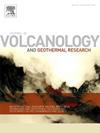岩浆-碳酸盐岩相互作用可在岩浆上升过程中提供水:意大利南部Campi Flegrei角砾岩Museo角卡岩捕虏体流体和熔融包裹体的结果
IF 2.3
3区 地球科学
Q2 GEOSCIENCES, MULTIDISCIPLINARY
Journal of Volcanology and Geothermal Research
Pub Date : 2025-06-30
DOI:10.1016/j.jvolgeores.2025.108405
引用次数: 0
摘要
本文报道并讨论了意大利南部Campi Flegrei角砾岩Museo矿床含矽卡岩矿物中流体包裹体(FIs)和熔融包裹体(MIs)的研究结果,以探讨岩浆与碳酸盐岩的相互作用。Campi Flegrei浅层岩浆房流体环境与斑岩型铜矿相关岩浆热液系统中记录的流体环境相似。矽卡岩形成于岩浆房的顶部和两侧,处于脆性-塑性过渡带,岩浆流体通过岩浆囊泡积聚,岩浆与碳酸盐岩相互作用。被困在橄榄石中的熔体包裹体,这里被称为盐碳酸盐-熔体包裹体(SCMI),为了解在这种环境下形成的熔体提供了重要的见解。在SCMI上进行的加热/冷却实验表明,他们捕获了一种均匀的熔体,在冷却时,熔体会瞬间分解,从而形成三种不相容的液体:硅酸盐、碳酸盐和水盐(盐水)。在SCMI中,假设微米尺度上的熔体行为再现了在大尺度上发生的情况,这意味着在过渡区,熔体在T >处保持均匀;当冷却到790°C以下时,立即不混合。为了解释SCMI收缩气泡中的瞬间解调和二氧化碳的缺乏,我们提出在高温度下CaCO3与H2O的反应(岩浆第二次沸腾)产生Ca(OH)2和H2CO3,它们溶解在均匀的熔体中,阻止了二氧化碳的形成。在较低的温度下,通过分解,CaCO3重新形成,释放出H2O。碳酸盐起着至关重要的作用,因为它在高温度下从均匀熔体中去除1摩尔的二氧化碳,同时在低温度下分解时释放2摩尔的H2O。我们认为,在岩浆上升过程中,这种供水可以促进岩脉向上扩展到地表,并在持续的喷发过程中增强爆炸性。本文章由计算机程序翻译,如有差异,请以英文原文为准。
Magma–carbonate country rock interaction can provide H2O during magma ascent: Results from fluid and melt inclusions in skarn xenoliths from Breccia Museo, Campi Flegrei (Southern Italy)
In this paper, the results of a study on fluid inclusions (FIs) and melt inclusions (MIs) hosted in skarn-bearing minerals sampled in the Breccia Museo deposits at Campi Flegrei (Southern Italy) are reported and discussed to investigate magma‑carbonate interactions. The Campi Flegrei shallow magma chamber fluid environment has been interpreted as similar to that documented in the magmatic-hydrothermal systems associated with porphyry copper deposits. Skarns form along the top and sides of the magma chamber in the brittle-plastic transition zone, where magmatic fluids accumulate through magmatic vesiculation and magma interacts with carbonate country rocks. Melt inclusions, here named saline‑carbonate-melt inclusions (SCMI), trapped in olivine, provide crucial insights into the melt that forms in this setting. Heating/cooling experiments on SCMI show that they trapped a homogeneous melt that, on cooling, undergoes instantaneous unmixing, leading to the formation of three immiscible liquids: silicate, carbonate and hydrosaline (brine). The melt behavior on micrometer scales, in SCMI, is assumed reproduces what happens on a large scale, this means that in the transition zone melt remains homogeneous at T > 980 °C and instantly unmixes when cooled below 790 °C. To account for the instant unmixing and the absence of CO2 in SCMI shrinkage bubbles, we propose that at high T the reaction of CaCO3 with H2O (by magma second boiling) produces Ca(OH)2 and H2CO3 that dissolve in the homogeneous melt and prevent the formation of CO2. At lower T by unmixing, CaCO3 re-forms, releasing H2O. The carbonate plays an essential role as it removes at high T, one mole of CO2 from homogeneous melt and simultaneously releases two moles of H2O at lower T when unmixing occurs. We argue that, during magma ascent, this water supply can facilitate the upward propagation of dyke to the surface and can enhance explosivity, during an ongoing eruption.
求助全文
通过发布文献求助,成功后即可免费获取论文全文。
去求助
来源期刊
CiteScore
5.90
自引率
13.80%
发文量
183
审稿时长
19.7 weeks
期刊介绍:
An international research journal with focus on volcanic and geothermal processes and their impact on the environment and society.
Submission of papers covering the following aspects of volcanology and geothermal research are encouraged:
(1) Geological aspects of volcanic systems: volcano stratigraphy, structure and tectonic influence; eruptive history; evolution of volcanic landforms; eruption style and progress; dispersal patterns of lava and ash; analysis of real-time eruption observations.
(2) Geochemical and petrological aspects of volcanic rocks: magma genesis and evolution; crystallization; volatile compositions, solubility, and degassing; volcanic petrography and textural analysis.
(3) Hydrology, geochemistry and measurement of volcanic and hydrothermal fluids: volcanic gas emissions; fumaroles and springs; crater lakes; hydrothermal mineralization.
(4) Geophysical aspects of volcanic systems: physical properties of volcanic rocks and magmas; heat flow studies; volcano seismology, geodesy and remote sensing.
(5) Computational modeling and experimental simulation of magmatic and hydrothermal processes: eruption dynamics; magma transport and storage; plume dynamics and ash dispersal; lava flow dynamics; hydrothermal fluid flow; thermodynamics of aqueous fluids and melts.
(6) Volcano hazard and risk research: hazard zonation methodology, development of forecasting tools; assessment techniques for vulnerability and impact.

 求助内容:
求助内容: 应助结果提醒方式:
应助结果提醒方式:


